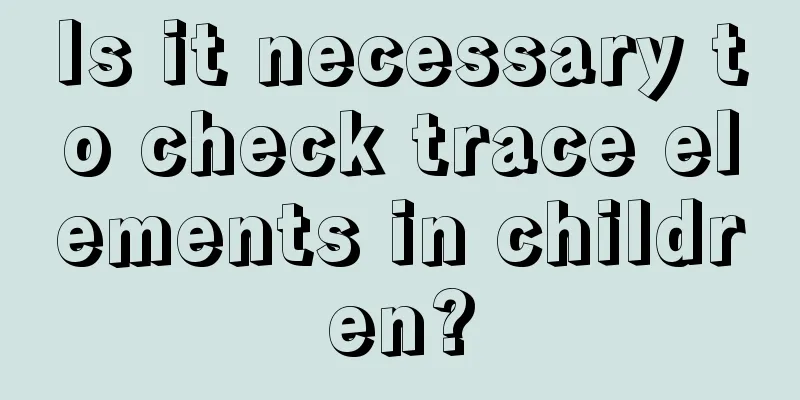Is it necessary to check trace elements in children?

|
When children have health problems during their growth process, parents are always particularly worried. Trace elements are some essential nutrients in our body. Once we lack trace elements, our body will have some problems, which will affect our health. Parents know that children's bodies are in a period of rapid growth and development and have high nutritional needs. However, they are always worried that their children lack trace elements, so they take their babies to check for trace elements. Let's find out whether it is necessary for children to check for trace elements. Is it necessary to check trace elements in children? There is no need for children to undergo trace element testing because there is no trace element deficiency under the current living standards. As the name suggests, trace elements are essential to the human body, but only in trace amounts. No matter how old the child is, as long as they can eat normally, there is no question of deficiency. The main trace elements in children's bodies are iron, zinc and copper. The normal values are: Iron: 60-170ug/dl, Zinc: 80-140ug/dl, Copper: 70-150ug/dl. These are the normal values provided in textbooks. Each hospital will have different reference values depending on the experimental methods provided by the laboratory. Generally, if you go to a regular hospital for trace element testing, you will get about 6 or 7 kinds of trace elements tested, and such test results are credible. Many parents now have a misunderstanding. They like to test their children's trace elements at every turn. After the test results come out, parents who find their children "qualified" are very happy, while parents who find their children "unqualified" become anxious and nervous, and give their children "crazy supplements" based on the test results. In fact, in the normal process of children's health care, parents generally do not need to take their children for trace element testing unless the child shows obvious clinical symptoms such as weight loss and picky eating. Trace element testing should not be a routine physical examination item. Parents should just pay attention to properly matching their children's diet. If you want to know whether your child's nutrition is balanced, in fact, a hemoglobin test during a health check-up is enough. Hemoglobin can show whether the child is anemic, and anemia is a symptom that children may currently experience. The above is an introduction to whether it is necessary to check trace elements in children. After understanding it, we know that as long as the child's diet is nutritionally balanced, it is generally not necessary to test the trace elements. I promise to eat more different foods and get nutritional value from different foods. Generally, there will be no lack of trace elements in the body. In addition, nourishing through drugs will have certain side effects on the body, but if you can get both nutrition and health through diet, it is a very reliable method. |
<<: At what age is it better to check the trace elements of the baby?
>>: The role of trace elements in baby testing
Recommend
How to treat peeling of children's feet
Our children are our treasures. It is not easy to...
What are the early symptoms of asthma in babies?
Asthma is a disease that really makes people feel...
Feeding knowledge for babies aged 1-2 months
Pay attention to the baby's feeding after bir...
What to do if your child has blisters on his tongue
In daily life, children are lively and active, an...
How to treat scarlet fever in children
Once a child develops scarlet fever, the symptoms...
What causes baby's knee joints to make noises?
Many mothers have found that their children's...
High lead level in baby
Family members cannot tell with the naked eye whe...
What should I do if my baby is a little zinc deficient?
Many parents do not know when their children star...
Solutions to the problem of babies not getting enough breast milk
Maybe we all have encountered the situation of ha...
What are the benefits of martial arts for children?
Children are in the period of growth and developm...
What kind of exercise can children do to grow taller?
Although we all know whether a person can grow ta...
What to do if your child has wind pimples
Children's skin is particularly delicate and ...
What's going on when my child poops and there's blood in it?
Generally speaking, if a child has blood in his p...
What causes children to vomit and feel nauseous?
Diseases are very common in people's lives, b...
What should I do if the gap between children's teeth is too big after they change their teeth?
Children must go through a stage when they grow u...









